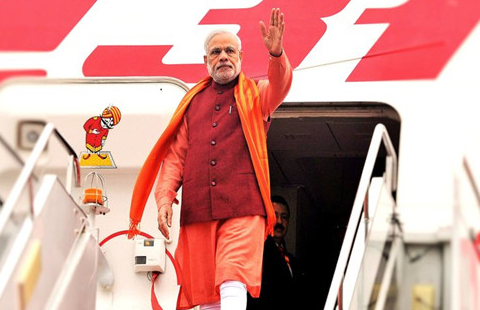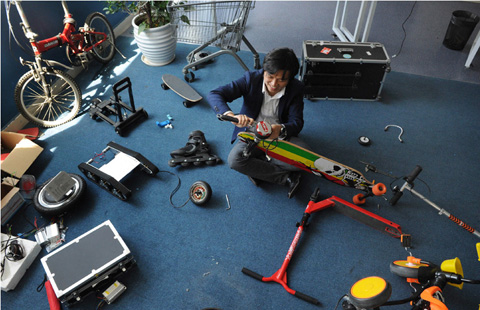
As building goes on, other countries' economic fortunes are rising
China has become a key economic partner for East Africa as China and Kenya embark on modernizing through ambitious infrastructure development programs.
Kenya, Tanzania and Uganda, in addition to enjoying robust relationships with China, are also well disposed to its companies because of the technical and financial muscle they believe they offer.
|
A Kenyan worker walks along the standard-gauge railway line that runs from Mombasa to Nairobi. The project is contracted to China Road and Bridge. Zhang Chen / Xinhua |

International consulting firm Deloitte said in a report published in March that China was responsible for building 31 percent of 51 projects under review in the region last year. This translates to about 16 projects; European and American concerns were responsible for nine projects between them.
It was the first time that China has clinched the top spot in the survey. In 2013 it was second after undertaking 19 percent of 93 projects; Europe and US topped the list by building 37 percent of them.
"The number of mega construction projects in East Africa has declined by 55 percent from the prior year," the report said, attributing the fall to the fact that many projects are still at the planning stage.
Kenya holds the lion's share of projects, followed by Uganda and Ethiopia.
"Tanzania holds just 7 percent and Rwanda 4 percent of the total East African projects," the report said.
The survey looked only at projects that are physically under construction and are valued at more than $50 million. Fifty-nine percent of the projects were related to transport, and 37 percent were focused on building energy capacity.
Since SinoHydro Corp, China Wu Yi Co and Sheng Li Engineering construction completed the 50.4 kilometer Thika super highway in 2012, Kenya's engagement with Chinese firms has ballooned.
China Road and Bridge is building a standard-gauge railway line in Kenya that runs from the coastal city of Mombasa to Nairobi and will eventually stretch to Uganda, Rwanda, Burundi and South Sudan. It will also link Mombasa to Ethiopia and will involve the use of a high-speed train running at up to 180 kilometers an hour.
Last year the Chinese Export-Import Bank signed a deal to finance 90 percent of the first phase of the standard-gauge railway line, and Kenya will foot the balance of the cost.
Anhui Construction Engineering Group and China National Aero-Technology International Engineering Corp are the chosen contractors for the Greenfield Terminal at Jomo Kenyatta International Airport in Nairobi.
On another regional project, the Lamu Port Southern Sudan and Ethiopia Transport corridor, the first contract was awarded to China Communications Construction Company, which is expected to build the first three berths at a cost of $480 million.
On the energy front, a consortium that involves three Chinese firms has won contracts to build a 960 megawatt coal-powered power station. Sichuan Electric Power Design and Consulting Company, Sichuan Power Construction Company and China Huadian Corporation Power Operation Company will work with two local companies, Centum and Gulf Energy, in the venture. It will be the single biggest power producer in the country.
The country is already including the benefits that it says will accrue from these projects in economic analysis. Work on the standard-gauge railway project, which began last year, has contributed 1.5 percent to the country's gross domestic product, it says.
Henry Rotich, the cabinet secretary of the Kenyan Treasury, has widely been quoted in the media as saying: "We will see higher GDP growth of 6.5 percent in 2015 and 7 percent by 2017."
Once the airport expansion is completed in 2017, the new $654 million terminal will increase passenger capacity from 6.5 million to 20 million. The number of passengers is forecast to grow 12 percent a year, taking the figure to 17.1 million by 2020 and 35.3 million by 2030.
Tourism, horticulture and other sectors are forecast to account for more than 10 percent of GDP by 2030.
In Tanzania, China Merchants International Company is building a port at Bagamoyo at a cost of $11 billion. It is estimated that the port, the biggest in the region, will be able to handle 20 times more cargo than the old port.
Industry experts attribute the success of Chinese companies in such big infrastructure contracts to their prudent business approach.
Two strands of this are the competitive prices and credibility they can offer. Kenya's Transport Ministry says China Road and Bridge was awarded the standard-gauge railway project in 2011 because it had the technical and financial muscle to deliver it within three years from 2014.
The company has operations in 40 countries and has undertaken several large railway development projects in China, including the Beijing-Shanghai high-speed railway and a line linking the northeastern cities of Harbin and Dalian.
"The lowest bidder might not always win, and that is why we have the Chinese firms building the railway instead of a UK firm," says Peter Muriu, senior lecturer of financial and monetary economics at the school of economics, University of Nairobi.
Over time, Chinese firms have proven they can complete projects on time and that the quality of their work is beyond reproach, he says.
That means governments do not face project delays and cost overruns, he says.
By looking to the East, he says, Kenya avoids heavy domestic borrowing that can push up loan interest charges. In the early 1990s, when aid from donor institutions such as the World Bank and the International Monetary Fund dried up, the economy ground to a halt.
"The private sector could not get affordable credit from our banks," Muriu says.
Now the government has access to funding from China and other foreign investors. The local private sector has enjoyed friendly loan terms. Since 2002, Kenya's economy has enjoyed a bullish run that peaked in 2007, when it grew 7 percent. Since then growth has averaged 5 percent a year.
Chinese construction firms have also brought a degree of stability to the sector. In the 1990s, when Western countries moved out of hard infrastructure and into utilities such as water and sanitation, the local private sector ballooned. However, it was soon swamped by unscrupulous operators that bid for big government projects even though they lacked the financial and technical wherewithal to complete them.
However, as the incidence of buildings collapsing increased and poorly built roads quickly fell into disrepair, the sector ran into trouble.
By having Chinese firms in charge of projects, the government has been able to clamp down on dubious companies through the National Construction Authority, which regulates the sector and sets standards.
The agency is encouraging partnerships between foreign and local companies, aiming to open up the market to competition and ensuring projects are completed on time. Moreover, it hopes to support technology transfer and improve capacity.
"Because of information asymmetry we may not know this, but partnerships between our firms and Chinese companies may be influencing the awarding of contracts to foreign firms," Muriu says.
Mary Kipkemoi, a lecturer at the private Strathmore University in Nairobi, says looking East has turned out to be lucrative to the region.
"China offers manpower, funds and even builds and operates the assets," she says.
Kipkemoi reckons that Kenya's attraction as an investment destination has increased, thus improving its ability to raise capital using financing alternatives such as Eurobonds.
"No one is angry that China is implementing projects, so international investors find interest at an average of 7 percent appealing," she says. "It is only in Africa where return on investment is guaranteed at over 5 percent."
A Eurobond is a debt security under which the issuer owes the holders a debt, and it is issued in a currency other than the currency of the country of origin.
Last July Kenya received $2 billion after it issued 10-year and five-year bonds on the Irish Exchange Market.
Kipkemoi says this funding alternative has greatly improved Kenya's credibility. It was a smart way of raising capital instead of using models such as build, own, operate and transfer that is well known in Asia, she says.
lucymorangi@chinadaily.com.cn
(China Daily Africa Weekly 05/15/2015 page8)








